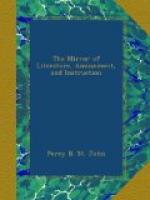purchased by the dealers and farmers of Norfolk, Suffolk,
and Essex. Opposite the cheese fair, on the north
side of the road, stood the small chapel, which was
then used as a warehouse for wool, hops, seed, and
leather[3]. Here were the wool-staplers, hop-factors,
leather-sellers, and seedsmen. The range of booths
in the front were for glovers, leather-breeches makers,
saddlers, and other dealers in leather. Opposite
to this, at the end of the line of show-booths, Garlick-row
commenced; the first range being occupied by hardwaremen,
silversmiths, jewellers, and fine ironmongery.
The next range was the row of mercers and linen-drapers,
where a draper from Holborn had a stock of not less
than 5,000_l_. value. The next range of booths
was occupied by stuff-merchants, hosiers, lacemen,
milliners, and furriers; here one vender has been known
to receive from 1,000_l_. to 1,200_l_. for Norwich
and Yorkshire goods. A lace-dealer from Tavistock-street
likewise attended here with a stock of 2,000_l_. value,
together with many other respectable tradesmen, with
goods according to the London fashion. Then followed
the ladies and gentlemen’s shoe-makers, hatters,
and perfumers; and next to the inn was an extensive
store of oils, colours, and pickles, kept by an oilman
from Limehouse, whose returns were seldom less than
2,000_l_. during the fair; and the father of the writer
of this article, who attended the fair during forty
years, usually brought away from 1,200_l_. to 1,500_l_.
for goods sold and paid for on the spot, exclusive
of those sold on credit to respectable dealers, farmers,
and gentry. On the outside of the inn were temporary
stables for baiting the horses belonging to the visiters.
The carriages were drawn up in the fields in a line
with the stables or standings for the horses.
Next was the oyster fair; the oysters from Lynn, called
the Lynn channel, were the size of a horse’s
hoof, and were opened with a pair of pincers.
At the bottom, in the Mead, next the river, was the
coal fair; opposite which were the pottery and fine
Staffordshire wares. Returning to and opposite
the oyster fair was the horse fair, held on the Friday
in the week after the proclamation. The show of
beautiful animals here was, perhaps, unrivalled by
any fair in the empire; the choicest hunters and racers
from Yorkshire, muscular and bony draught-horses from
Suffolk and every other breeding county, drew together
dealers and gentlemen from all quarters, so that many
hundreds of valuable animals changed masters in the
space of twelve hours. Higher up was Dockrell’s
coffee-house and tavern, spacious and well stored with
excellent accommodations. About 200 yards onward
was Ironmonger-row, where the dealers from Sheffield,
Birmingham, Wolverhampton, and other parts, kept large
stocks of all sorts of iron and tin wares, agricultural
implements, and tools of every description. About
20 yards from them, westward, and bordering on the
road, were slop-sellers, dealers in haubergs, wagoners’
frocks, and other habiliments for ploughmen; and next,
the Hatters’-row. Behind Garlick-row, next
the show booths, stood the basket fair, where were
sold rakes for haymakers, scythe-hafts, and other
implements of husbandry, of which one dealer has been
known to sell a wagon-load or two.




